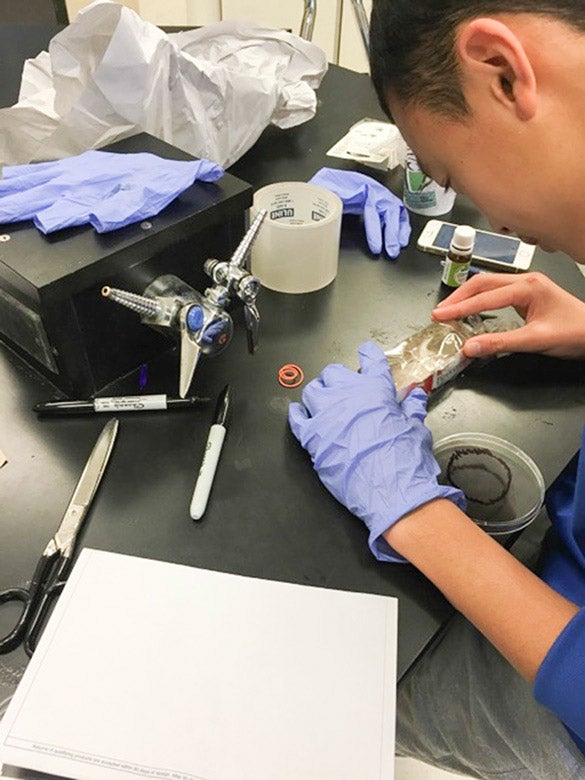It all started with a search of ratemyteachers.com. In summer 2015, Cooper Galvin, Stanford graduate student in biophysics, was looking for a highly rated science teacher at a school in need of science outreach.

High school student Tiffany Nguyen pots plants in airtight containers to measure their carbon dioxide absorption under different light conditions. Jocelyn Luna calculates the maximal load a spider silk bridge can sustain relative to a bridge built of normal silk. (Image credit: Cooper Galvin)
From that search, Galvin met with Patrick Allamandola, a teacher at San Jose’s Andrew P. Hill High School. Over coffee they started brewing a plan to bring much-needed mentorships and resources to science-interested students at the school. The result was FAST: Future Advancers of Science and Technology.
“We came up with this plan of grad students going down there, meeting in small groups of high school students and dreaming up projects of their invention,” said Galvin. “Basically following their curiosities and figuring out how to make it real.”
Now, every other Saturday, juniors and seniors at the high school meet with Stanford graduate students and postdoctoral scholars to grow their interests in gene editing, biomimetics and other topics in science. Students build valuable science experience by creating and seeing through experiments, and they also develop lasting relationships with their mentors.
Need for science community
Galvin looked at Andrew P. Hill because “there was clearly a need,” he said. Many students at the school in the East Side Union High School District come from Latino and Vietnamese immigrant backgrounds. And over 50 percent are on the free and subsidized lunch program. Most are living in poverty, said Galvin.
The school also lacks resources for these students, who often struggle to complete science fair and senior capstone projects. In the school’s International Baccalaureate program, a single teacher mentors about 20 students on their capstone projects, which require rigorous work and attention to detail to succeed.
“There are few opportunities that they have in their community for a space that they can go and think creatively,” said Galvin.
Following curiosity
John Mai was one of the students who participated in FAST last year. After hearing about FAST in class, he started going to every Saturday meeting. He joined the CRISPR group, where he explored the potential of different genes to act as “reporters” in bacterial cells. Stanford graduate students Becky Fu and Mariya Chavarha mentored Mai by helping him craft his project and see it to fruition.

High school student Hubert Le observes collective motion in ants as they respond to chemicals of different scents. He constructed environments and filmed the ants, tracking their movements. (Image credit: Cooper Galvin)
“I am really thankful for my mentors because of how much they helped me with my project, and how much they encouraged me to pursue my passion in a career in science,” said Mai.
This style of empowering students to ask questions and do their own research is the hallmark of FAST. In this project-based learning, students start with their own curiosities, asking questions about whether brushing their teeth eliminates bacteria or how much helmets reduce the force of an impact. Mentors then help figure out how scientific knowledge fits with the students’ interests.
Last year, student curiosities led to competitive science fair projects and high scores on senior capstone projects. Mai went to the district science fair and won first place in biology. But the mentorship didn’t stop there, he said. His mentor motivated him to apply to a highly competitive internship at Stanford (SIMR – Stanford Institutes of Medicine Summer Research Program), which he was accepted into.
Now Mai is majoring in biotechnology at the University of California, Davis. He still talks to Fu, who also went to UC Davis, about his educational goals – possibly a graduate degree at Stanford.
“I think [FAST] was life changing, because without this program I wouldn’t have gained as much experience in science as I wanted to in high school, and might have not continued my interest for science,” said Mai.
Shifts in science
This year, FAST has already more than doubled. About 100 students attend every Saturday meeting, compared with 40 last year. Galvin wants to continue to grow the program by encouraging more Stanford undergraduates to participate and organizing college workshops.
In just its first year, Galvin has seen great enthusiasm for the program. “There’s a shift in the way that students are realizing how they can engage in science,” Galvin said. “They’re happy to talk about science with their friends, they’re happy to talk about the details, they’re happy to challenge each other to think about things in a more rigorous way.”